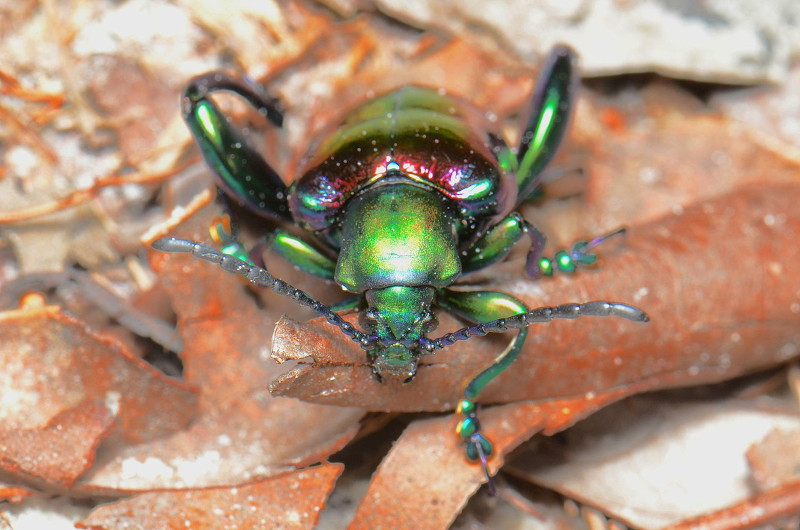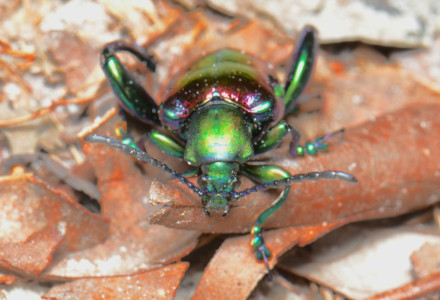
Photographer: Pavel Kirillov
CC License: https://bit.ly/37hyszl
Frog Legged Beetle Facts
- First of all, the awesome Frog Legged Beetle remains a most unusual species of beetle. Its common name derives from the rather striking resemblance of its hind legs to those of a frog. But, these remarkable appendages are no evolutionary quirk, because they serve an important function.
- To begin with, unlike an actual frog, the invertebrate does not use the over-sized legs for jumping. Rather, these powerful legs help the remarkable insect hold tightly to the stems of various plants. In this manner, the surprising invertebrate remains firmly attached while feeding.
- Furthermore, this amazingly colored invertebrate also remains renowned for its enormous cocoons. These appear quite commonly in the jungles of the native habitat of the fascinating species. In this marvel-filled location, one most commonly finds them clinging to climbing vines.
- This beautifully colored insect also sometimes goes by the name of the kangaroo beetle. By whatever name one calls it, researchers remain unable to acquire sufficient data about it. Due to this, therefore, the IUCN does not have a listing for it, as of this moment, due to insufficient information.
Related Articles
Tansy Beetle Goliath Beetle Atlas Beetle
Photo Credit: Smithsonian National Museum of Natural History Insect Zoo/ Butterfly Pavilion
CCL: https://bit.ly/3ioKe14
Frog Legged Beetle Physical Description
One of the points of interest about the awesome Frog Legged Beetle remains its sheer size. That’s because mature specimens of the fabulous arthropod average a length of roughly 1-2 in (2.5-5 cm). The fabulous beetle also displays sexual dimorphism in terms of size. The males reach about twice the size of the females.
Given this larger than common size, it stands our from among related creatures. That fact occurs even without regard to its distinctive appearance. But, that particular characteristic of the impressive animal certainly deserves its own mention. This animal represents one of the most visually distinctive of all known beetles.
Firstly, its chitin presents a wide variety of colors with the most common one being a bright green. In fact, these colors also display as rather highly iridescent in nature. The oversized hind legs also develop far more pronounced among males of the species. Finally, the wings remain fully functional, though it rarely flies.
- Kingdom: Animalia
- Phylum: Arthropoda
- Class: Insecta
- Order: Coleoptera
- Family: Chrysomelidae
- Genus: Sagra
- Species: S. buqueti
Photographer: Pavel Kirillov
CC License: https://bit.ly/3xrqiii
Frog Legged Beetle Distribution, Habitat, and Ecology
The region in which the fantastic Frog Legged Beetle evolved will probably come as no surprise to many of our readers. That holds true due to the fact that it evolved as endemic to areas filled with amazing creatures. That consists of portions of Malaysia, Java, Sumatra, Borneo, and the Philippines, in Asia.
In addition, within its native range, it typically inhabits regions of the dense, tropical jungle. There, the natural coloring of the species serves to provide it with excellent natural camouflage. Also, in this location, the larva typically spins its cocoon on a wide variety of native climbing vines.
Quite unfortunately, researchers still know very little else about the life cycle of this beautiful insect in its native habitat. Although individuals have been reared in captivity and studied, their behavior patterns likely differ from those in the wild. Sadly, the nature of that natural habitat makes such studies difficult.
Species Sharing Its Range
Jade Vine Javan Rusa Reticulated Python
Check out our other articles on 9 Bewildering African Plants, North Sulawesi Babirusa, Onyx River, Vampire Squid, Blue Footed Booby, Loggerhead Sea Turtle, Wood Frog

